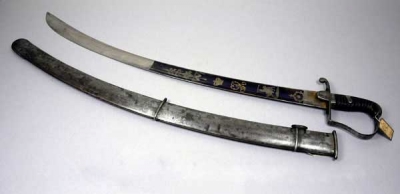Light Cavalry sabre (2007.56.1)
 EnglandLight Cavalry sabre from England, Europe. Owned by Professor Stephen Rigaud of the Oxford University Volunteer Corps. Given to the Museum by his son John Rigaud in 1888.
EnglandLight Cavalry sabre from England, Europe. Owned by Professor Stephen Rigaud of the Oxford University Volunteer Corps. Given to the Museum by his son John Rigaud in 1888.
This British Light Cavalry sword was the first sword of standard specification to be issued to British Army officers in 1796. The sabre’s curved blade is based on Asian swords - in particular, the Indian talwar - and was famously effective at the Battle of Waterloo in 1815. Surplus or obsolete models were often distributed to the Army’s auxiliary units such as, in this case, the Volunteer Corps.
This fine example was owned by Professor Steven Rigaud, mathematician, astronomer, Fellow of Exeter college and officer in the Oxford University Volunteers in the early 19th century. Although of the shape of an Army issued sword, it’s embellishments suggest it was purchased privately. It has a gold and ivory handle and an engraved, blued and gilt blade with motifs including floral scrolls, a swordsman on horseback, a crown, the initials ‘GR’ (the monogram of George III) and a coat of arms with a lion & unicorn and the inscription, Dieu et mon Droit (‘God and My Right’, the motto of the British monarchy that refers to the monarch's divine right to govern).
Form and Function
The sabre finally entered widespread military use in England in the late 18th century after a long and winding journey over hundreds of years from the weapon's origins in Asia. Although some medieval Crusaders returned from the Holy Land with the curved sword of the Saracens, many years would pass before it would oust the flat broadsword and then the thrusting rapier as the weapon of choice.
It is known that the Eurasian Avars - a Ukrainian nomadic people forced into Eastern Europe by Persian expansion in the 6th century - used the curved sword because they inherited the sword culture of central and southern Asia. By the 9th century, the Hungarians and Russians had adopted the curved sword and this is where our term 'sabre' comes from the Hungarian word szablya meaning 'to cut'.
The preference for using a curved sword on horseback came from the discovery that a cutting blow delivered in a downward and backward slicing action from a height actually elongated the amount of blade that came into contact with the enemy's body. In Western Europe, the decision to adopt the sabre as a cavalry weapon stemmed from the decision to emphasise the cut above the thrust even though cuts tend to be less fatal than thrusts. The reasoning behind this was convincing - the cut is a more instinctive blow and it was found that when pressed in combat, cavalrymen often resorted to slashing movements even if their sword was a thrusting rapier-type. Also, an effective cut can be delivered to any part of the body whereas a thrust has to hit the head or an internal organ to strike home. It was accepted that an enemy incapacitated by a cut, particularly to a limb, was as useless in battle as if he had been killed.
John Gaspard Le Marchant (1766-1812), a respected officer, combined such 'scientific' and tactical logic with extensive testing and consultation with swordsmen when he was put in charge of coming up with the specifications of a regulation sword to be used by all British cavalry. The resulting 1796 Pattern Light Cavalry Sword had a curve that was thought extraordinary at the time. It was deemed to be the first rationalised and original creation stipulated for compulsory use among officers and achieved considerable fame as a model of British military engineering. A 1796 Pattern Heavy Cavalry Sword was also issued but it was heavier and straighter since their reduced mobility still favoured a stabbing action. That these models were actually near-exact copies of the 1775 Austrian cavalry swords was conveniently glossed over as they carried the British army to eventual victory in the Napoleonic Wars.
Yet, just fashions and expectations change and advance today, so too did the 'revolutionary' 1796 pattern soon find itself out of favour. Many complained that it was unwieldy compared to contemporary French swords, that the metal scabbard dulled the blade and that its blunt hatchet point (as seen on this example) - designed to withstand contact with dense bone or metal - did not perform in a thrusting action. Many examples of the 1796 pattern have been found with modified, sharpened tips in an effort to overcome this limitation and provide a dual-purpose cutting and thrusting weapon.
By 1831, these concerns seem to have been largely forgotten as the 1796 pattern was replaced with a scimitar blade that resembled the Persian shamshir - even longer, narrower and more curved and even less suitable for thrusting! Apparently, this change of heart had been influenced and endorsed by celebrity: Arthur Wellesley (1769-1852), First Duke of Wellington became Commander-in-Chief in 1827 and chose to wear an Egyptian Mamluk sword he had received as a gift on campaign. Such was the Duke's status and appeal that British officers soon began to adopt the trend and thus was borne the long tradition in the British Empire for the adoption of Arabic sabre-type swords by all manner of senior personnel.





